Hackable Android handheld game device uses Cortex-A8 SoC
Dec 10, 2009 — by Eric Brown — from the LinuxDevices Archive — 38 viewsHardKernel is shipping a developer-focused handheld game device that runs Android and offers source code, schematics, and a debug board. The $350 Odroid is based on a Cortex-A8 Samsung S5PC100 clocked to 833Mhz, and offers 10GB of flash, a 3.5-inch touchscreen, 720p video via HDMI, plus WiFi, Bluetooth, and accelerometers.
Korea-based HardKernel tipped its Odroid device in September, and by late October, SlashGear was reporting that the first run of 500 devices was sold out via pre-order. HardKernel confirms this and boasts that the Odroid "is the hottest item at Aesop, the biggest Korean Linux developer community."
The Odroid is now shipping, says the company, presumably with many more devices ready to fill orders. The 5.9 x 3.0 x 0.6-inch (150 x 76 x 15mm) device primarily targets mobile gaming, but also serves as a general-purpose ARM Cortex-A8 reference/development platform, says the company.
The Odroid ("Open-Android") runs an optimized Android OS aimed at the general open source developer community, and ships with a full hardware schematics and full source code based on a Linux 2.6.27 kernel (see farther below). The company encourages developers to spin off both the hardware and software "into a variety of different Android-based gadgets."
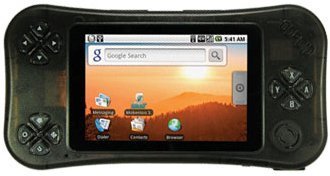
HardKernel's Odroid, developer edition

Samsung S5PC100 block diagram
(Click to enlarge)
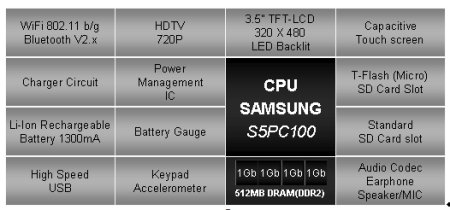
Odroid block diagram
(Click to enlarge)
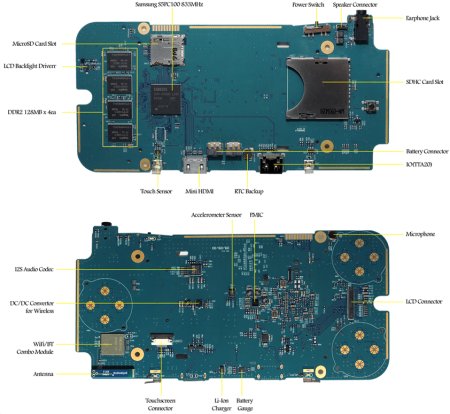
The Odroid PCB is composed of a 12-layer stack.
(Click to enlarge)
- Processor — Samsung S5PC100 (Cortex-A8 clocked at 833MHz)
- Memory — 512MB DDR2
- Flash — 10GB (2GB Micro-SD for u-boot/kernel/Android system, 8GB SDHC for user space)
- Flash expansion — SDHC slot for up to 32GB
- Display — 3.5-inch, 320 x 480, capacitive touchscreen
- Video — supports 720p via HDMI cable (H.264+AAC MP4 format)
- Networking:
- LAN — 802.11 b/g
- PAN — Bluetooth 2.x
- Other I/O:
- USB 2.0 high speed port with bus-powered charging
- Line out/in
- UART for development
- Mini-HDMI video out connector with SPDIF audio
- 3.5mm headphone jack
- Other features:
- Built-in speaker and microphone
- 3-axis accelerometer
- Gaming-oriented keypads
- Serial monitor debugging board
- Dimensions — 5.9 x 3.0 x 0.6 inches (150 x 76 x 16mm)
- Weight — 5.6 oz (160g) with battery
- Battery — 1300mAH rechargeable lithium-ion (2 pcs); extra charger input
- Operating system — Android 1.5R3 with Linux 2.6.27
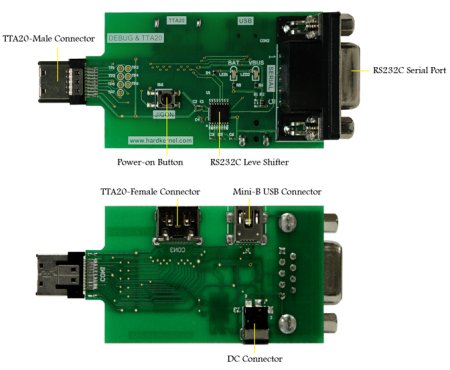
Odroid's companion serial monitor debugging board
(Click to enlarge)

Odroid driving 720p output via HDMI
(Click to enlarge)
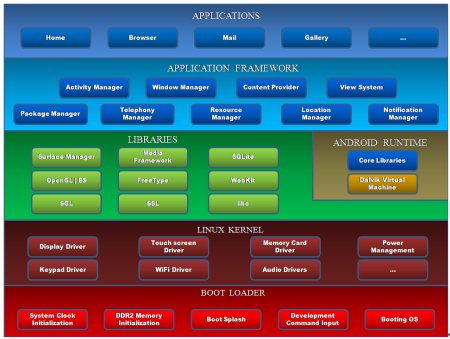
Odroid software architecture
(Click to enlarge)
- Android Cupcake 1.5R3 (recently moved up from 1.5FR)
- Sensor handling for accelerometer with proper reference axis to JNI
- WLAN power management added (Bluetooth power management not yet ready)
- More stable capacitive touch screen input device driver
- OpenCore Media framework now ported to utilize hardware accelerator for H.264 and other Codecs
- Correctly using 3D hardware for OpenGL ES via HGL library, with bugs fixed for fog, compressed texture, lighting, shader update, etc.
- USB driver for ADB and mass storage
- HDMI hot plug for video as well as audio through HDMI's SPDIF
- HD media playback for both LCD and HDTV at different resolutions
- Hardware-based JPEG engine for faster image operations
- RTC bugs fixed
- ALSA audio driver with I2S audio codec
- iROM booting for Micro-SD card, for U-boot and Android system file
- Battery device driver for Android power management
All components are open source except for the 3D library HGL and surface flinger copy-bit library, which "are not open source due to Samsung's intellectual property policy," says HardKernel. Regular software updates are planned, with the next version based on Donut (Android 1.6), and Eclair (Android 2.0) also being considered, says the company.
Odroid running Android 3D Game demo on YouTube; additional YouTube video showing 720p output may be found here
.)
The Odroid is available now to developers for $350, including schematics, source code, and debug board, says HardKernel. Full source code access will be available by end of this year via the Odroid git server.
More information may be found here. The earlier story on the Odroid on SlashGear may be found here.
This article was originally published on LinuxDevices.com and has been donated to the open source community by QuinStreet Inc. Please visit LinuxToday.com for up-to-date news and articles about Linux and open source.